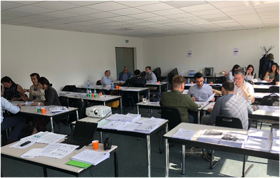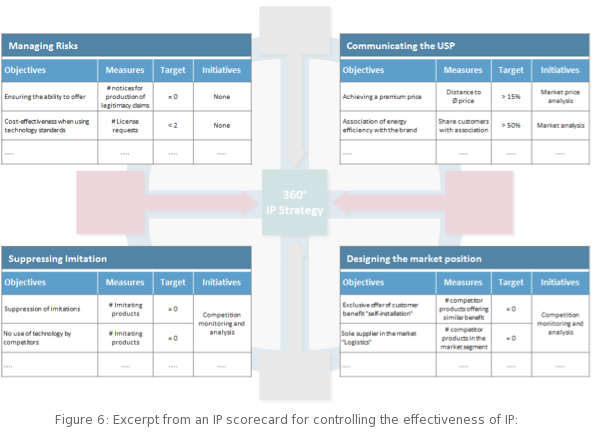MIPLM 2017-18 – 5th module on leadership and controlling in IP management
People are a key resource for companies in the knowledge economy. So human resource management (HRM) and leadership are core competencies and sources of competitive advantages for IP-driven companies. In the 5th module of the MIPLM in IP management, the participants gained an understanding of staff and people as individuals with varying goals, needs, and motivations. In this module, companies and organizations were understood as a conglomerate of individuals in an interdisciplinary setting. HRM was seen as an economic theory in itself, combined with interdisciplinary influences from sociology, organizational psychology, pedagogy, and business administration. A core part of this module was to explore the extent to which innovation and HRM are interdependent; how effective human resource management can enhance innovation capabilities within the organization, and how an innovation culture may drive a need to reshape HRM systems.
 In different case studies, the current practice of HRM in knowledge- and creativity-driven companies was discussed. Google, for example, is organized around the ability to leverage the talent of exceptional technologists and business people. Google considers itself lucky to recruit many creative, principled, and hard-working stars. Knowledge-based industries mainly focus on their inputs of technology and human capital, and human resources have become the single most important determinant of success and growth for companies in this sector. The case of Facebook’s amazing talent management practice is particularly insightful in this respect. In addition, the leadership development practice at 3M was discussed along with approaches to staff motivation at Siemens. A case study on motivation and teamwork at Starbucks Corporation provided insights in rapid globalization and heavy competition of businesses, and their reaction in terms of HRM activities.
In different case studies, the current practice of HRM in knowledge- and creativity-driven companies was discussed. Google, for example, is organized around the ability to leverage the talent of exceptional technologists and business people. Google considers itself lucky to recruit many creative, principled, and hard-working stars. Knowledge-based industries mainly focus on their inputs of technology and human capital, and human resources have become the single most important determinant of success and growth for companies in this sector. The case of Facebook’s amazing talent management practice is particularly insightful in this respect. In addition, the leadership development practice at 3M was discussed along with approaches to staff motivation at Siemens. A case study on motivation and teamwork at Starbucks Corporation provided insights in rapid globalization and heavy competition of businesses, and their reaction in terms of HRM activities.
In the second part of this module, management control systems were discussed while fostering an understanding of the necessity of management control systems, their different types, and their relevance for business success. The ways in which intangible assets are usually integrated into management control systems and the prerequisites and limitations of IP management control systems were presented. Finally, the focus was on developing practical skills for appropriate IP management control systems.
Leadership Case Study
Development of KPIs for IP Investment Controlling
The Thermomix success story
The Thermomix TM5 was launched in September 2014 to replace its predecessor, the TM31, which had already been on the market since 2004. The TM5 represents Vorwerk’s digital transformation. Not only is this food processor able to weigh, cut, mix, boil, and steam food, but it can also process digital recipe data stored on recipe chips or downloaded from its recipe platform on the Internet. By means of these data, the TM5 automatically processes recipes and guides the user through the cooking process via its graphic user interface (see Fig. 1).

Vorwerk uses a direct distribution concept for the TM5. Over 16,500 representatives demonstrate the TM5 directly to potential buyers in a domestic setting. These representatives are themselves avid users of the device and are therefore able to communicate the differentiating features and USPs of the product with passion and a personal touch in a live cooking experience. Market analyses performed by Vorwerk show a very strong correlation between customer satisfaction and intensity of product use: the greater the frequency of use, the greater the customer’s satisfaction. The marketing goal for the TM5 is therefore derived from its business model: turning the Thermomix into an essential part of daily life and people’s daily dietary choices. “Daily usage” is the central marketing goal because it leads to greater satisfaction and therefore to an increase in recommendations and the desire to become a representative.
Recipe availability and quality are central levers for the “daily usage” goal. Vorwerk’s value proposition for the TM5 are recipes with a success guarantee. It is extremely important for users to associate a successful outcome with the cooking process. The Thermomix enables users to prepare dishes which would otherwise exceed their competences and possibilities. In addition, users can use the time freed up by the automated phases of the cooking process outside of the kitchen. The trigger for customer satisfaction is a successful outcome combined with great flexibility and time savings. Recipe data are therefore the driver of the business model for the TM5.

Users’ “recipe journeys” often begin with the following question: “What should I cook today?” This is the most frequently asked question on Google in Germany. The intensive analysis of the recipe journey from the recipe search to the cooking process, commenting, customizing, and saving recipes has shown Vorwerk that this journey is characterized by inconsistencies, media disruption, and gaps. In addition, dietary requirements must also be taken into account in the quest for a suitable recipe. This includes replacing specific ingredients for people with food allergies, for instance. What is more, users tend to follow dietary trends such as low carb, weight loss, healthy or vegetarian diets when looking for recipes.
 In order to satisfy these requirements and to create the recipe-related basis for “daily use”, Vorwerk has developed tested and verified recipe chips which can guide the cooking processes. Unverified recipes would be harmful to the Thermomix device and cannot guarantee successful cooking, so prevention of unauthorized third-party access to the mechanical and electronic data is necessary. In addition, hackers must be prevented from accessing the control unit and recipe chips must be compatible. Running verified and quality-assured recipes on the Thermomix requires a license. Therefore, the recipe chips also serve as a control protocol and security interface for the device.
In order to satisfy these requirements and to create the recipe-related basis for “daily use”, Vorwerk has developed tested and verified recipe chips which can guide the cooking processes. Unverified recipes would be harmful to the Thermomix device and cannot guarantee successful cooking, so prevention of unauthorized third-party access to the mechanical and electronic data is necessary. In addition, hackers must be prevented from accessing the control unit and recipe chips must be compatible. Running verified and quality-assured recipes on the Thermomix requires a license. Therefore, the recipe chips also serve as a control protocol and security interface for the device.
To make sure the consumers have enough choices for recipes, Vorwerk created a complex, varied, and integrated digital ecosystem called “World of Thermomix” around the Thermomix. This includes a recipe search function, dietary advice, and grocery delivery (see Fig. 2). The central component is the recipe platform called “Thermomix Rezeptwelt” (in English: “Thermomix Recipe Community”) with hundreds of thousands of registered users and thousands of recipes. In Germany alone, approx. 5 million recipes are downloaded from “Thermomix Rezeptwelt” every month.
Thermomix promises successful cooking, individualized cooking, and simplicity of operation. In order to achieve these promises, Vorwerk has integrated the recipe software with the hardware of the TM5. The TM5 receives its recipes initially via recipe chips and then via the Internet and guides the user through the cooking process. This “guided cooking” leads to a special self-directed and autonomous cooking experience which, at the same time, leaves the user feeling confident not to make any mistakes when following the individual steps. Simple, quick, and flexible cooking combined with quality-assured recipes is at the core of the Thermomix success guarantee.
The IP concept in the context of competitive differentiation for the TM5
The IP strategy developed for the Thermomix is based on the core ideas of the 4P concept. The starting point is competitive differentiation, based on the simplified notion that competition is due to the fact that customers will select those products and services from the different options provided by different companies which offer them the best perceived benefit. This fundamental customer choice is crucial because this component is exactly what needs to be influenced by means of IP. The customer’s willingness to pay a certain price will ultimately depend on whether a product or service offers the best perceived benefit. In order to successfully enforce premium prices, it is necessary to create a position of exclusivity which, in the view of the customer, offers the perceived customer benefit. One of the essential positions in the case of the Thermomix is “guided cooking” in connection with a smooth and hurdle-free “recipe journey”.
 The role of IP in the 4P concept is schematically illustrated in Figure 4. A differentiated communication of customer benefits is required in order to leverage customers’ willingness to pay. One way of conceptualizing this strategy is the 4P concept derived from the “4Ps” of marketing (product, promotion, price, point of sale). It is important to note here that the 4P concept is not just a concatenation of terms but rather a concept consisting of integrated and interrelated elements.
The role of IP in the 4P concept is schematically illustrated in Figure 4. A differentiated communication of customer benefits is required in order to leverage customers’ willingness to pay. One way of conceptualizing this strategy is the 4P concept derived from the “4Ps” of marketing (product, promotion, price, point of sale). It is important to note here that the 4P concept is not just a concatenation of terms but rather a concept consisting of integrated and interrelated elements.
Customer-centric IP generation begins with the USP (unique selling proposition). This selling proposition must be communicated to the customer in a suitable and comprehensible manner. This is best achieved by means of a UCP (unique communication position). IP ensures legal enforceability for both unique positions. The ideal conditions for achieving premium prices are given when a legally protected unique selling proposition is met with the customer’s willingness to pay.
The commercial success of the Thermomix is undisputed and impressive: 50% sales increase for Vorwerk to EUR 1.4 billion with the Thermomix within a year. Over 2 million TM5 units sold worldwide and on average one home selling party in Germany every 22 seconds. These home selling parties serve the purpose of learning how to use the Thermomix without having to consult a user manual. This is probably the most obvious way of documenting the “easy to use” aspect. The representatives are themselves passionate users and evangelists of the product. What is more, intensive competitive activity is easy to recognize. Especially since the TM5, the Thermomix has been recognized as a dominant design within its competitive environment. Imitations and lookalikes attempt to position themselves as closely as possible to the dominant product in the market.
An important feature of the Thermomix worth mentioning is the sequence of tones by which millions of Thermomix devices indicate the end of the cooking process. The idea that a food processor from a discount store would be allowed to sound just like a Thermomix triggered alarm bells among everybody involved. Sound marks play an extremely important role within the scope of acoustic brand management. Even toddlers are able to  recognize the Thermomix by the ascending sequence of tones at the end of the cooking process. In the meantime, this four-tone sound has been protected by a sound mark. Vorwerk protected the unique selling point of high data safety by covering the data compatibility of the Thermomix by means of copyrights and database rights, and the locking mechanism by means of patent rights. The company took a similar approach for protecting its guaranteed recipe success. The exterior design was protected by design rights, 3D trademarks, and figurative marks. Accessories such as blades or the spatula now proudly carry the Thermomix logo – above all to recognize fraud quickly and easily, and to effectively eliminate plagiarism.
recognize the Thermomix by the ascending sequence of tones at the end of the cooking process. In the meantime, this four-tone sound has been protected by a sound mark. Vorwerk protected the unique selling point of high data safety by covering the data compatibility of the Thermomix by means of copyrights and database rights, and the locking mechanism by means of patent rights. The company took a similar approach for protecting its guaranteed recipe success. The exterior design was protected by design rights, 3D trademarks, and figurative marks. Accessories such as blades or the spatula now proudly carry the Thermomix logo – above all to recognize fraud quickly and easily, and to effectively eliminate plagiarism.
This situation inspired the subject of exclusivity monitoring in order to determine the effects of the IP strategy for the TM5:
- Is IP suitable for securing the market position? How sustainably can benefits be protected?
- How long does it take for the exclusivity to erode?
- Can the exclusivity achieved through IP be described by means of KPIs?
Controlling of intangibles
Ever since the increasing importance of intangible assets (IA) was discovered in the 1990s and the impact of IA on shareholder value and corporate growth was confirmed, there has been intensive debate on how to control such intangible and non-financial assets. The value structures of companies have seen a dramatic transformation over the past 30 years. Depending on the evaluation methods and metrics used, intangible assets account for the lion’s share of a company’s value (sometimes even more than 90%). A direct monetary valuation of intangible assets, and especially of intellectual property, is usually unsuitable for operational purposes. Operations management and senior management as well as supervisory bodies much rather require a summative overview of a company’s IP situation. The core tasks of the operational IP controlling can be summarized as follows:
- Transparency
IP controlling provides information which is of relevance for planning, steering, target achievement, budgeting, and controlling. - Resource allocation
Definition of specific objectives and prioritization of specific areas in which exclusivity is to be achieved. Ensuring that the resources are used to achieve these goals. - Controlling
Definition of specific objectives and monitoring of goal achievement lead to a systematic integration of IP with the company’s business model and thus ensure maximum benefits. - Optimization
Continuous monitoring, documentation and analysis of IP-related costs and benefits permit a goal-oriented design and optimization of the IP portfolio based on KPIs.
Strategy implementation requires the definition of specific controlling objectives. These must be defined in accordance with the specific characteristics of IP. The definition of controlling objectives in order to design meaningful controlling tasks is therefore of critical importance when managing IP in a corporate environment. We must distinguish between three different perspectives in this respect:
- Efficiency perspective
Monitoring and steering of the efficiency of the IP process by identifying potentials for optimization. - Learning perspective
Monitoring of the degree to which the goals defined for the IP strategy are being attained. Analysis of deviations from the target in order to improve future IP activities. - Optimization perspective
Optimization and steering of the degree to which the goals defined for the IP strategy are being attained and summarization of the information for future IP budgeting.
The design of IP controlling should be embedded in the company’s existing information structure. By defining suitable KPIs (Key Performance Indicators), the wealth of information available can be compacted to just a handful of metrics. In addition, it is necessary to integrate an IP controlling process which continuously captures, documents, and evaluates the relevant data in defined intervals and prepares them for decision-making.
KPIs are a well-established management tool. They condense the information measured in the form of ratios or absolute figures and provide quantitative information about the situation. However, an appropriate and success-relevant picture of the situation can usually not be obtained by using a single KPI but rather by employing several KPIs and looking at their interrelations and quantitative correlations (also known as KPI systems).
IP asset controlling and balanced scorecard
IP asset controlling seeks to control the success of the 360° IP strategy and its implementation, and map it by means of an IP scorecard. By verifying whether the objectives set in the strategy development process have been achieved, the value contributions made by IP in the business model are brought to the fore. This type of reporting highlights the benefits of these measures in a direct and credible way. IP experts no longer have to rely on assumptions regarding the value contribution to the operative business, which are difficult to verify and sometimes prone to speculation. IP asset controlling therefore provides the basic information required by senior management of such entities in order to assess whether an investment in IP was justified. In addition, being able to recognize unmet IP goals provides an opportunity for further analysis of the reasons for such lack of success. The lessons learned can in turn be used for future strategy development and implementation. Last but not least, success monitoring and analysis also provide the possibility of determining future IP budgets in a goal-oriented manner.
The outcomes of IP asset controlling are mapped onto an IP scorecard. This tool was derived from the so-called balanced scorecard, a tool for communicating, monitoring, and controlling the implementation of business strategies. The balanced scorecard was developed by Robert P. Kaplan and David P. Norton in the 1990s. Its inventors had realized that traditional systems of metrics, which were exclusively focusing on financial aspects, were no longer an adequate recipe for success in the light of an increasingly tough competitive environment and the ever-increasing importance of intangible value drivers. Kaplan and Norton therefore added further, non-monetary performance indicators to these management systems. These KPIs clearly define the company’s business goals and the measures required for implementing its strategy. By sharing the balanced score card with all employees, everybody obtains a clear picture of the chosen course and can make their contribution towards achieving the required results.
The KPIs of the balanced scorecard relate to the company’s strategy. According to Kaplan and Norton, there are four main strategic perspectives: the learning and development perspective, the process perspective, the customer perspective, and the financial perspective. For each of these perspectives, quantifiable indicators are defined, which describe the company’s objectives in the best possible way. Each indicator is, in turn, attributed measures which highlight the path to goal achievement. Fixed setpoint values for the indicators show the target ranges for the individual aspects. Measuring the ACTUAL values and comparing them with the TARGET values provides an indication of the company’s success in pursuing its goals as well as a starting point for actively controlling its activities.
 While the balanced scorecard focuses on steering the implementation of a strategy, the IP scorecard is aimed at measuring the degree of goal attainment by means of implemented IP measures. The 360° IP strategy consists of four perspectives: managing risks, suppressing imitation, designing the market position, and communicating the USP. These four areas are represented on the scorecard. In addition, goals to be achieved by designing IP assets are defined within the scope of strategy development.
While the balanced scorecard focuses on steering the implementation of a strategy, the IP scorecard is aimed at measuring the degree of goal attainment by means of implemented IP measures. The 360° IP strategy consists of four perspectives: managing risks, suppressing imitation, designing the market position, and communicating the USP. These four areas are represented on the scorecard. In addition, goals to be achieved by designing IP assets are defined within the scope of strategy development.
This demonstrates that the development of a 360° IP strategy is a prerequisite for the development of an IP scorecard – a fact which is immediately obvious because a meaningful evaluation of the success of an objective is only possible if that objective has been defined prior to taking specific measures. Once objectives have been defined, they must be translated into indicators which allow us to visualize success in terms of the contribution of IP within the business model.
When defining KPIs, it is essential that they focus on the desired market effect rather than the IP rights as such. The basic information required in order to quantify these KPIs is usually not provided by the patent department but by business functions which are close to the market.
Case Study Tasks and Questions
Develop KPIs to measure the value contribution made by IP for the present case. Please refer to the objectives of the Thermomix IP strategy.
- Task 1:
Develop a 360° objectives matrix for Thermomix based on the information provided. - Task 2:
Come up with examples of KPIs which are suitable for measuring target achievement in the “Managing Risks” segment of the 360° IP strategy. - Task 3:
Think of examples of KPIs which are suitable for measuring target achievement in the “Suppressing Imitation” segment. - Task 4:
Come up with examples of KPIs which are suitable for measuring target achievement in the “Designing the market position” segment. - Task 5:
Think of examples of KPIs which are suitable for measuring target achievement in the “Communicating the USP” segment.



